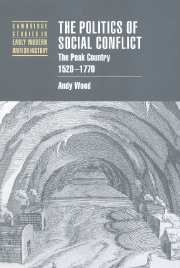Book contents
- Frontmatter
- Contents
- List of figures
- List of tables
- List of maps
- Preface
- List of abbreviations
- Introduction ‘Terms we did not understand’: landscape, place and perceptions
- 1 Social relations and popular culture in early modern England
- Part I The structures of inequality
- 2 Economy and society in the Peak Country, c. 1520–1570
- 3 Industrialization and social change, c. 1570–1660
- 4 The Peak Country as an industrial region, c. 1660–1770
- 5 Social conflict and early capitalism
- Part II The conditions of community
- Part III The politics of social conflict
- Bibliography
- Index
- Cambridge Studies in Early Modern British History
2 - Economy and society in the Peak Country, c. 1520–1570
Published online by Cambridge University Press: 27 July 2009
- Frontmatter
- Contents
- List of figures
- List of tables
- List of maps
- Preface
- List of abbreviations
- Introduction ‘Terms we did not understand’: landscape, place and perceptions
- 1 Social relations and popular culture in early modern England
- Part I The structures of inequality
- 2 Economy and society in the Peak Country, c. 1520–1570
- 3 Industrialization and social change, c. 1570–1660
- 4 The Peak Country as an industrial region, c. 1660–1770
- 5 Social conflict and early capitalism
- Part II The conditions of community
- Part III The politics of social conflict
- Bibliography
- Index
- Cambridge Studies in Early Modern British History
Summary
TECHNOLOGY AND INDUSTRY
The responses of educated Augustan visitors to the Peak Country may have been scripted, and their views of the Peak's inhabitants patronizing or dismissive. But at least their writings provide some contemporary sense of the region and its people. The further the historian's reach extends back in time, the more elusive becomes the world of the ‘Peakrills’. Even the most comprehensive accounts of sixteenth-century England shed little light upon the region. Camden understood Derbyshire's division into a pastoral, industrial north and an agrarian south, and knew that in the ‘mountains, lead stones are daily digged up in great abundance’, but his account of the lead industry was well out of date at the time of its publication. In his journeys of 1535–43, John Leland missed the Peak. His only mention of the area noted its two market towns, the ‘Castel of the hy Peke longging to the King’, and sketched the routes of its major rivers, the Derwent and the Wye. He intended to discuss the boundaries, forests, monastic houses, the ‘Notable Places of Gentilmen’ and the ‘Frutefulnes of the Shire’, but never completed the task. The Peak lay upon the margins of his journeys, his writings and his England.
In the absence of colourful travel writings, the historian of the sixteenth century Peak Country must rely upon the archive, and here too the record is uneven. The economic history of the late medieval region has been reconstructed in some detail.
- Type
- Chapter
- Information
- The Politics of Social ConflictThe Peak Country, 1520–1770, pp. 41 - 56Publisher: Cambridge University PressPrint publication year: 1999



